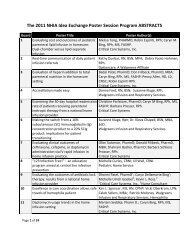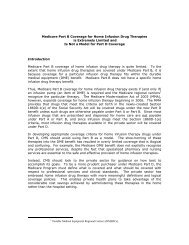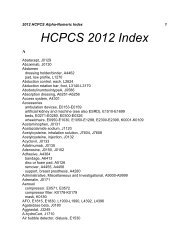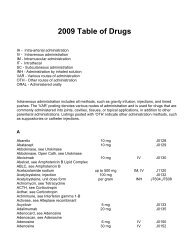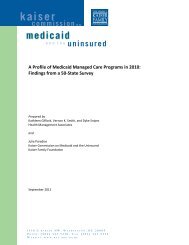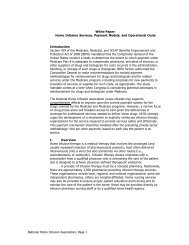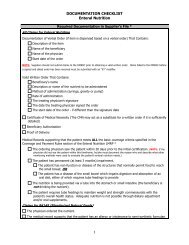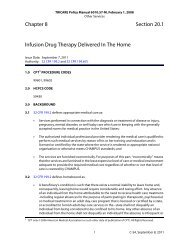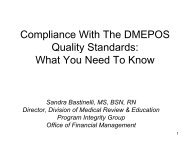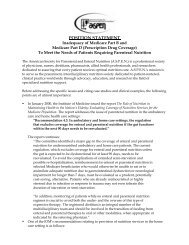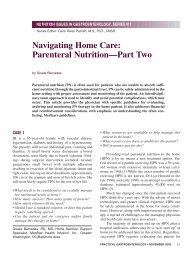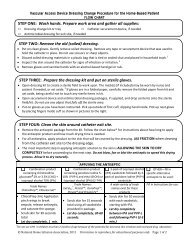IgG Therapy for the Home-Based Patient: Administration and ... - NHIA
IgG Therapy for the Home-Based Patient: Administration and ... - NHIA
IgG Therapy for the Home-Based Patient: Administration and ... - NHIA
You also want an ePaper? Increase the reach of your titles
YUMPU automatically turns print PDFs into web optimized ePapers that Google loves.
The primary driver in <strong>the</strong> success of that educational ef<strong>for</strong>t is<br />
being sure that <strong>the</strong> patient knows what to expect. The home<br />
infusion care team should create a care plan that details <strong>the</strong><br />
number of infusions per week/month <strong>the</strong> patient will have, an<br />
estimated time <strong>for</strong> each infusion, <strong>the</strong> volume being infused, <strong>and</strong><br />
<strong>the</strong> number of sites accessed. This in<strong>for</strong>mation—along with a<br />
set of supplies, written instructions, <strong>and</strong> pharmacy contact in<strong>for</strong>mation—should<br />
be supplied prior to <strong>the</strong> teaching visit.<br />
Typically, patients <strong>and</strong>/or caregivers can become independent<br />
in as few as two or three teaching visits (see Exhibit<br />
5). During <strong>the</strong> first visit, <strong>the</strong> nurse per<strong>for</strong>ms <strong>the</strong> entire administration,<br />
explaining each step as <strong>the</strong> patient observes.<br />
There should be time <strong>for</strong> <strong>the</strong> patient to ask questions <strong>and</strong><br />
get acquainted with <strong>the</strong> many various supplies. The second<br />
visit is a t<strong>and</strong>em administration with <strong>the</strong> patient per<strong>for</strong>ming<br />
<strong>the</strong> majority of <strong>the</strong> tasks with verbal cues from <strong>the</strong> nurse.<br />
The nurse may per<strong>for</strong>m certain tasks, such as <strong>the</strong> needlestick.<br />
By <strong>the</strong> third visit, <strong>the</strong> patient should be able to per<strong>for</strong>m<br />
all of <strong>the</strong> tasks with only minimal cuing from <strong>the</strong> nurse. If<br />
<strong>the</strong> patient or caregiver is not fully independent, more visits<br />
may be offered. Additional support, such as phone assistance<br />
<strong>and</strong> access to manufacturer teaching materials, may<br />
also be offered.<br />
Ano<strong>the</strong>r critical element <strong>for</strong> success is regular followup.<br />
Phone calls to check on patient progress <strong>and</strong> answer questions<br />
aid in compliance <strong>and</strong> help patients avoid complications<br />
that can sometimes arise from lapses in technique.<br />
<strong>Patient</strong>s should be made aware of what to expect during<br />
SCIG administration. Typically, <strong>the</strong> first several infusions result<br />
in a stretching, burning, tingling feeling at <strong>the</strong> injection site.<br />
This sensation usually disappears after <strong>the</strong> tissue in <strong>and</strong> around<br />
subcutaneous space becomes sensitized. <strong>Patient</strong>s may continue<br />
to experience sunburnlike redness <strong>and</strong> swelling at <strong>the</strong><br />
injection site <strong>and</strong> a “goose egg” reservoir of fluid in <strong>the</strong> subcutaneous<br />
space, due to <strong>the</strong> volume of infusion. These fluid pockets<br />
generally disappear within 6 24 hours as <strong>the</strong> fluid is<br />
absorbed into <strong>the</strong> body. It’s common <strong>for</strong> patients to feel tenderness<br />
<strong>and</strong>/or discom<strong>for</strong>t at <strong>the</strong> infusion site 12 24 hours following<br />
administration; counsel <strong>the</strong>m to choose activities <strong>and</strong><br />
even clothing appropriately. <strong>Patient</strong>s may also experience<br />
bruising 5 10 days after an infusion, <strong>and</strong> should know not to<br />
be alarmed by <strong>the</strong> delayed appearance of bruising.<br />
Exhibit 5<br />
Core Elements of <strong>Patient</strong> Education<br />
• <strong>Therapy</strong> regimen. The patient’s lifestyle must accommodate more frequent (weekly vs. monthly) administrations.<br />
<strong>Patient</strong>s must also underst<strong>and</strong> that compliance with an independent self administration schedule is essential to<br />
good outcomes.<br />
• Anaphylaxis procedures. Review epinephrine autoinjector use <strong>and</strong> storage procedures in <strong>the</strong> event of an anaphylactic<br />
reaction.<br />
• H<strong>and</strong> hygiene. Proper h<strong>and</strong> hygiene is a core element in all effective infection control programs, including in <strong>the</strong> patient’s<br />
home.<br />
• Site selection <strong>and</strong> preparation. <strong>Patient</strong>s should be involved in determining which site(s) to use <strong>for</strong> infusion based<br />
on com<strong>for</strong>t, body mass, convenience, etc. They should also be counseled on how to recognize improper needle<br />
length <strong>for</strong> <strong>the</strong> site used (i.e. A needle that is too long may brush muscle wall causing bruising <strong>and</strong> discom<strong>for</strong>t, or a<br />
needle that is too short can infuse intradermally, increasing <strong>the</strong> severity of local infusion site reactions.)<br />
• Supplies. <strong>Patient</strong>s should receive a list with all <strong>the</strong> supplies needed <strong>for</strong> <strong>the</strong>ir care along with storage/h<strong>and</strong>ling instructions.<br />
Inventory awareness <strong>and</strong> appropriateness should also be stressed with patients during <strong>the</strong> training<br />
phase, as <strong>the</strong>y will be expected to assist <strong>the</strong>ir pharmacy with <strong>the</strong>ir supply needs <strong>and</strong> should know how to communicate<br />
supply <strong>and</strong> usage needs.<br />
• Priming needles. <strong>Patient</strong>s should be instructed that all ef<strong>for</strong>t should be taken to insert a dry needle so that <strong>IgG</strong> is<br />
not being tracked through <strong>the</strong> dermis, triggering a possible histamine release <strong>and</strong> increasing <strong>the</strong> probability of a<br />
local site reaction.<br />
• Needlestick procedure. Teach patients to insert <strong>the</strong> needle into <strong>the</strong> subcutaneous space <strong>and</strong> how to avoid intradermal<br />
injection. Proper placement of <strong>the</strong> needles limits leaking, discom<strong>for</strong>t, <strong>and</strong> localized site reactions. Also teach<br />
90degree angle insertion, avoiding scars, skin folds, or keloids.<br />
• Needle Securement: Apply tape over <strong>the</strong> needle in a chevron pattern to hold it securely in place during <strong>the</strong> infusion,<br />
minimizing <strong>the</strong> risk of dislodgement <strong>and</strong> subsequent intradermal infusion.<br />
• Disposal of trash <strong>and</strong> medical waste. Instruct patients on state <strong>and</strong> local regulations <strong>and</strong> to have appropriate<br />
garbage receptacle ready be<strong>for</strong>e <strong>the</strong> administration procedure begins.<br />
• Adverse reactions. While local site reactions are <strong>the</strong> most common, patients should also be educated regarding <strong>the</strong><br />
rare risks of aseptic meningitis, renal compromise, <strong>and</strong> cardiac compromise – particularly if <strong>the</strong>re is comorbidity.<br />
• Troubleshooting. Caution patients that <strong>the</strong> use of heating pads may increase a histamine response. Icing with a<br />
cold water bottle be<strong>for</strong>e needle placement minimizes pain <strong>and</strong> can enhance com<strong>for</strong>t. Chronic leaking or redness at<br />
<strong>the</strong> site should be a sign <strong>for</strong> <strong>the</strong> patient to discuss <strong>the</strong> needle length <strong>and</strong>/or pretreatment with <strong>the</strong>ir clinician.<br />
<strong>IgG</strong> <strong>Therapy</strong> <strong>for</strong> <strong>the</strong> <strong>Home</strong><strong>Based</strong> <strong>Patient</strong>: <strong>Administration</strong> <strong>and</strong> Delivery Method Considerations 7



